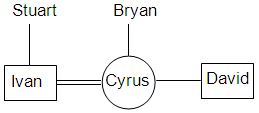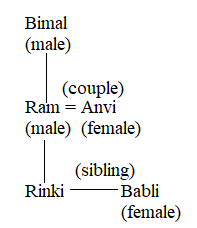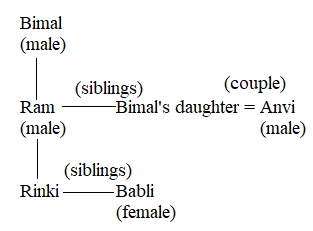SLAT Mock Test - 3 (New Pattern) - CLAT MCQ
30 Questions MCQ Test - SLAT Mock Test - 3 (New Pattern)
Ivan is the son of Stuart. David is the son of Bryan. Ivan is married to Cyrus. Cyrus is Bryan's daughter. How is David related to Ivan?
Ninu was born on 3rd March, 1980. Mini was born 3 days before Ninu. The Republic Day of that year fell on Saturday. Then, Mini's birthday was on
Directions: In the following question, a letter series is given with one term missing. Choose the correct alternative that would follow the same pattern in the given series.
DKY, FJW, HIU, JHS, ?
Directions: In the following question, a series is given with one or two terms missing. Choose the correct alternative from the given options that will complete the series.
2, 9, 28, 65, 126, __
In a certain language, OPTIMIST is written as RSWLPLVW. How will ENCOURAGE be written in that language?
Directions: The words in the pair given below have a certain relationship between them. Select from the answer choices the pair of words having the same relationship.
Pitcher : Water
Directions: There is a certain relationship between the two terms to the left of the sign (: :). The same relationship exists between the two terms to the right of it, out of which one is missing. Find the missing term from the given alternatives.
121 : 144 : : 169 : ?
If SCOTLAND is 12345678, LOAN is 1435, LOTS is 8124, DAN is 537 and SON is 458, then C is
Directions: Choose the odd numeral pair from the following alternatives:
Today is 1st August. The day of the week is Monday. This is a leap year. The day of the week on this date after 3 years will be a
If Anvi says, Rinki's father, Ram, is the only son of my father-in-law, Bimal, then how is Babli, who is sister of Rinki, related to Bimal?
Directions: The question consists of two statements, one labelled as Principle(s) and the other as Facts. You are to examine the Principle(s) and apply it/them to the given Facts carefully, and select the best option.
Principle: Wherever the causing of a certain effect, or an attempt to cause that effect, by an act or by an omission, is an offence, it is to be understood that the causing of that effect partly by an act and partly by an omission is the same offence.
Facts: A intentionally causes Z's death, partly by illegally omitting to give Z food and partly by beating Z.
Has A committed murder by not giving food to Z?
Directions: The question consists of two statements, one labelled as Principle(s) and the other as Facts. You are to examine the Principle(s) and apply it/them to the given Facts carefully, and select the best option.
Principle: Where one of the parties to a contract is in a position to dominate the decision of the other party, the contract is enforceable only at the option of the party who is in a position to dominate the decision of the other party.
Facts: A businessman asked an engineer that he would make a payment of Rs. 2,50,000 for repair of machinery. The engineer received an amount of Rs. 1,25,000 and the businessman promised to pay the remaining amount after the repair. After maintenance, the businessman was satisfied with his work. The engineer demanded the remaining amount from the businessman, but he refused to pay.
Decide.
Directions: Read the following situation and choose the correct answer to the question asked.
Situation: Arjun gave his bow for repair to Bhim. Bhim, after repairs, sold it to Karan. Karan knew that it was Arjun's bow when he was purchasing the same.
Which of the following statements is true?
Directions: The sentence given below is a legal principle followed by a factual situation based on the legal principle. Choose the correct option, which relates both the principle and the situation.
Legal Principle: A person is liable for all the injurious consequences of his careless act.
Factual Situation: Ramesh, a snake charmer, was exhibiting his talents to a group of people. One of the snakes escaped and bit a child who had to be hospitalised for two days for treatment. Is Ramesh liable to compensate the child's family?
Directions: The sentence given below is a legal principle followed by a factual situation based on the legal principle. Choose the correct option, which relates both the principle and the situation.
Legal Principle: A person is guilty of culpable homicide amounting to murder if the act by which the death is caused is done with the intention to cause death.
Factual Situation: A was hiding behind a bush to catch some rabbits. B also came to the same place for hunting with his gun.
When B noticed some movements behind the bush, he thought it was an animal and fired a shot due to which A was killed.
Can B be prosecuted for murder?
Directions: The question consists of two statements, one labelled as Principle and the other as Facts. You are to examine the principle and apply it to the given facts carefully and select the best option.
Principle: Proposal (communication) + Acceptance (communication) + Consideration = Contract. The communication of a proposal is complete when it comes to the knowledge of the person to whom it is made.
Facts: X's nephew absconded from home. He sent his servant in search of the boy. After the servant had left, X offered to pay Rs. 501 to anybody finding his nephew. The servant came to know of this offer only after he had already traced the missing child. He, therefore, brought an action to recover the reward.
Decide.
Directions: The question consists of two statements, one labelled as Principle and the other as Facts. You are to examine the principle and apply it to the given facts carefully and select the best option.
Legal Principle: Every partner in a partnership firm is liable for the acts of every other partner during the course of business of the partnership firm.
Factual Situation: A, a partner in the firm XYZ with another partner B takes loan from a bank for the partnership firm. A misuses the fund for his personal use. B is a very resourceful person. Can the bank demand the entire money from B?
Directions: The question consists of one or more principle and some facts. You are to examine the principle(s) and apply it/them to the given facts carefully, and select the best option.
Principle: A violation of legal right, with or without damage, gives rise to a tort.
Facts: P is a very violent and impatient person. On the other hand, Q is a very patient person. Both of them don't agree at a particular point and there is a difference of opinion. P in a fit of rage punches Q, but Q is not hurt due to the punch for some good reason. Q sues P for the tort of trespass to the person.
Directions: The question consists of two statements, one labelled as Principle and the other as Facts. You are to examine the principle and apply it to the given facts carefully and select the best option.
Principle: A contingent contract is a contract to do or not to do something, if some event, collateral to such contract, does or does not happen.
Facts: A agrees to pay B a sum of Rs. 15 lakh if B marries C latest by March 31, 2015. Due to unavailability of marriage hall, B could marry C only on April 7, 2015. B claims Rs. 15 lakh from A.
Decide.
Directions: The question consists of two statements, one labelled as Principle and the other as Facts. You are to examine the Principle and apply it to the given Facts carefully and select the best option.
Legal principle: The Constitution of India guarantees freedom of speech and expression to all the citizens, subject to the power of the State to make a law and impose restrictions on this freedom in the interest of sovereignty and integrity of India, the security of State, friendly relations with foreign States, public order, decency or morality or in relation to contempt of court, defamation, incitement of an offence.
Facts: Joy TV, a Hong Kong based Satellite TV Company, introduces a new channel called as 'Channel XXX' which can be viewed in India. It is meant for adults since it telecasts only adult films. The Government of India passes a law and bans viewing of this channel and other similar channels in India. It also banned reception and circulation of such programs by cable TV operators throughout India. The Cable TV Operators' Federation in New Delhi filed a writ petition in the Supreme Court challenging the validity of the new law as it is contrary to freedom speech and expression.
What could be the main argument on behalf of Government to justify their action?
What is a proposed strategy to ensure fair compensation for farmers and potentially reduce financial distress?
What is one of the key strategies suggested to help farmers manage climate-related challenges more effectively?
Which approach is recommended to enhance the financial stability of farmers?
What is the primary goal of the BHASHINI platform?
Which bacterial strain has been identified as effective in breaking down PFAS compounds?
What are 'forever chemicals' primarily known for?
What is the primary goal of the National Critical Minerals Mission (NCMM) launched by the Indian government?
Which of the following minerals is considered critical for the production of electric vehicle batteries?
























